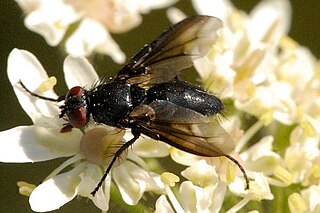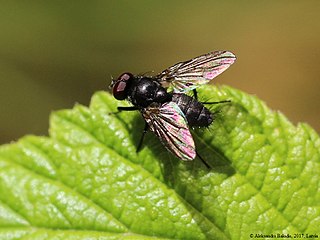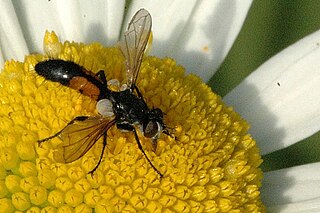
Sturmia is a genus of flies in the family Tachinidae.
Baumhaueria is a genus of flies in the family Tachinidae.
Botria is a genus of flies in the family Tachinidae.

Campylocheta is a genus of flies in the family Tachinidae.
Ethilla is a genus of flies in the family Tachinidae.

Exorista is a genus of flies in the family Tachinidae.

Frontina is a genus of flies in the family Tachinidae.
Gaedia is a genus of flies in the family Tachinidae.

Oswaldia is a genus of flies in the family Tachinidae.

Phyllomya is a genus of flies in the family Tachinidae.
Tryphera is a genus of flies in the family Tachinidae.

Wagneria is a genus of flies in the family Tachinidae. More junior homonyms exist of Wagneria than any other animal genus name.

Kirbya is a genus of flies in the family Tachinidae.
Labigastera is a genus of flies in the family Tachinidae.
Bessa is a genus of flies in the family Tachinidae.

Allophorocera ferruginea is a species of bristle fly in the family Tachinidae.

Cylindromyiini is a tribe of flies in the family Tachinidae. It contains about 17 genera and 200 species.

Compsilura concinnata is a parasitoid native to Europe that was introduced to North America in 1906 to control the population of an exotic forest, univoltine, spongy moth named Lymantria dispar. It is an endoparasitoid of larvae and lives with its host for most of its life. Eventually the parasitoid ends up killing the host and occasionally eating it. It attacks over 200 host species, mainly insects from the Orders: Coleoptera, Lepidoptera and Hymenoptera. Since this parasite has the ability to attack many different types of hosts, the organism has spilled over from the intended forest systems into other areas, like agricultural fields, affecting cabbage pests including the cabbage looper (Trichoplusia); the cabbage worm ; and even other invasive species such as the brown-tail moth. However, it also attacks native, non-pest insects such as the Cecropia moth and American moon moth.
Phyllomya procera is a species of fly in the family Tachinidae.

Pales pavida is a species of bristle fly in the family Tachinidae.












